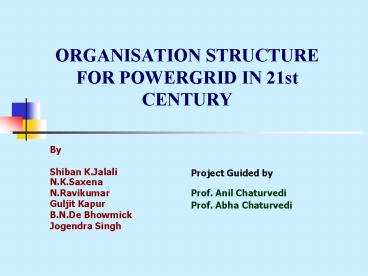ORGANISATION STRUCTURE FOR POWERGRID IN 21st CENTURY - PowerPoint PPT Presentation
1 / 19
Title:
ORGANISATION STRUCTURE FOR POWERGRID IN 21st CENTURY
Description:
ORGANISATION STRUCTURE FOR POWERGRID IN 21st CENTURY By Shiban K.Jalali N.K.Saxena N.Ravikumar Guljit Kapur B.N.De Bhowmick Jogendra Singh Project Guided by – PowerPoint PPT presentation
Number of Views:247
Avg rating:3.0/5.0
Title: ORGANISATION STRUCTURE FOR POWERGRID IN 21st CENTURY
1
ORGANISATION STRUCTURE FOR POWERGRID IN 21st
CENTURY
- By
- Shiban K.Jalali
- N.K.Saxena
- N.Ravikumar
- Guljit Kapur
- B.N.De Bhowmick
- Jogendra Singh
Project Guided by Prof. Anil Chaturvedi Prof.
Abha Chaturvedi
2
PRESENT STRUCTURE OF POWERGRID
- Traditional
- Hierarchical
3
FEATURES OF PRESENT STRUCTURE
- Pressure on individuals to deliver results
- Focus on individual not team accountability
- Get the Job Done motivation
- Hierarchical system of Delegation control
4
MINDSET RESULTED BY PRESENT STRUCTURE
- Resistance to innovation
- People produce output, therefore Manage
- people to manage output
- Manage by Results, Objectives
5
Implication of present Structure
- Only People are responsible for the output - good
or bad - Fear in the minds of people
- Distortion of facts as communications get
filtered - An attitude of SAVE YOUR SKIN in the organization
- Fire-fighting to get the job done
- Insufficient time to document. Priority is on
task Completion - Delay in decision making process due to long
Hierarchy - Lack of Team work
6
PRESENT ENVIRONMENTAL SHIFTS
- Demand for creation of Backbone High Capacity
Transmission Corridor - Demand for more efficient technology
- Enactment of Electricity Act 2003
- End of 55 year old State monopoly
- Introduction of Open Access
- Competition in Business
- Regulatory Regime
- Uncertainty in Tariff Structure
7
MAJOR CHALLENGES
- High Cost of wrong decision
- Filling gaps in Technology and Technical
expertise - Continuous improvement in organisational
efficiency - Aligning of processes to the demands of delivery
- Credible and timely documentation
8
NEED OF THE HOUR
- Responsive decision making
- Developing/Upgrading Technical Capability
- Managing diversity of businesses and markets
- Accountability for Asset Management and
utilisation - Review of Technical, Decisional and
administrative processes - Effective on-line documentation system
9
Action Plan
- Corporate Centre only for policy decisions
- Decentralization of all the functions
- Concept of Zones in Each Electrical Region
- Each zone will be profit centres
- Introduction of development (Cost) Zones
- Four tier Hierarchy
- Decision making process in a more participative
manner
10
REDEFINING FOUR TIER HIERARCHY
- E1 to E5 Level 4 To have 5 grades Working
Level - E6E7 Level 3 To have 2 grades
- E7AE8 Level 2 To have 2 grades
- E9 Level 1
- Elevation to higher grade within a level - based
on time scale - Elevation to higher levels based on Interview
11
DISTRIBUTION OF EXECUTIVES IN NEW STRUCTURE
Level 1
Present Distribution
15
E-9 15
E-8 26
E-7A 67
E-7 203
E-6 350
E1-E5 1938
Level 2
93
Level 3
553
1938
Level 4
12
Broad Organisation Structure with Heads
CC
CMD
Region
Region
Region
Level 1
Zone
Zone
Zone
Level 2
Station
C A O
Station
Level 3
13
Role of Corporate Centre
- Formulation of Policy
- Standardisation of various Engineering, Operation
and Maintenance activities - Diversification into other Business areas
- Quality Assurance and IS
- Planning MIS
- Project Approval
- Fund Mobilisation and Allocation
- Interface with various Central Govt Agencies and
CERC - ERP implementation
- Commercial Tariff finalisation
- International Business Development
Back
14
Role of Regions
- New Projects
- Engineering
- Contracts
- Project Monitoring
- Operation and Maintenance
- AMP
- Disaster Management Coordination
- Interface with REB/RLDC
- Commercial
- Billing
- Realisation
- Data for Tariff petition
- Interface with SERC if needed
- Business Development
- Manpower Planning and HRD
Back
15
Role of Zones
- New Projects
- Detailed Engineering
- Project Monitoring, Expediting
- Field Quality Assurance
- Operation and Maintenance
- AMP Monitoring
- Coordination for Major Maintenance Activities
- Expediting Bill Realisation
- Business Development
- Balance sheet for the Zone
Back
16
Role of Station and CAO
- Station
- Round the clock Shift Duties
- Maintenance of Substations and lines
- Implementation of AMPs
- Construction Area Office (CAO)
- Project execution
- Implementation of field quality
Back
17
CONCLUSION
- In light of the huge expansion and growth of the
organisation, the proposed structure will be a
step towards - Decentralisation
- Reduction in hierarchy resulting in
- Quick decision making
- Boost for Innovation
- Encouragement to participative Management
- Improvement in Communication
- Rationalisation of career growth process
18
CONCLUSION(contd.)
In addition to the proposed structure, a cultural
shift along with required matching processes need
to be in place to overcome the constraints and
achieve the desired results.
19
THANK YOU






























